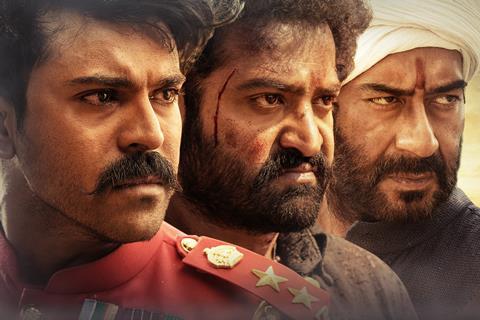S.S. Rajamouli smashes records with his big-screen spectacular

Dir/scr: S.S. Rajamouli. India. 2022. 180 mins.
When it comes to spectacle, S.S. Rajamouli delivers. And then some. His latest action-packed audience-pleasing adventure epic RRR has smashed numerous box office records and helped revive cinema-going, especially for the domestic market. Riotous good fun from start to finish, RRR, a fictionalised account of two real-life revolutionaries fighting against the British Raj and Nizam of Hyderabad in 1920s India is being deservedly championed for reminding audiences what big screen entertainment is all about.
Big, bold and bombastic, this is big screen entertainment at its best.
The second most expensive Indian film ever made, with a budget of $72 million (second only to 2018’s 2.0 which came in at $75 million), with the highest opening day collection by an Indian film ($31m), RRR has also just taken the mantel as the fifth highest grossing Indian film of all time (at the time of writing it has taken $99m at the global box office, with $65m of that from its opening weekend, and admissions continue to climb). Yet perhaps RRR was a sure thing given Rajamouli’s previous success with his Baahubali films; Baahubali: The Beginning (which took more than $100m globally) and Baahubali 2: The Conclusion (which took $254m globally), and his two big star lead actors, N.T. Rama Rao Jr, grandson to Telugu actor politician N.T. Rama Rao, and Ram Charan, both of whom are multi award-winning performers. But what is most remarkable about RRR, however, is its deeply affecting tone.
N.T. Rama Rao Jr. (aka Jr. NTR) plays the kind-hearted Komaram Bheem, revolutionary of the Gond tribes, while Ram Charan is Alluri Sitarama Raju, who waged armed revolution against British colonial rule. The similarities to their real-life counterparts are slight, with Rajamouli’s epic imagining what might have happened if the pair had met during the undocumented periods in their lives before their fights for India’s independence truly took hold.
The film begins in the Adilabad Forest, with the first ‘R’ accounted for – StoRy – where a young girl, Malli (Twinkle Sharma) is taken from her mother at the behest of the British governor’s wife, who thinks the young girl’s henna artistry and charming nightingale song would make her an ideal addition to the mantelpiece. This is the narrative act that will later put everything in motion for Bheem.
The second ‘R’ comes from FiRe, where we are first introduced to Raju (Charan), who will do anything to get a promotion – including a single-handed fight sequence that defies the odds and probably gravity just to prove his indomitable spirit, otherworldly strengths and oddly aligned allegiance to the crown. Set on the outskirts of Delhi, where riots are being led by Lala Lajpat Rai, Raju must do more than just ‘hold the line’ if he wants to get noticed. The action sequence that follows is nothing short of incredible, with Raju emerging as a jaw-dropping physical force to be reckoned with. This chapter also includes what must be the most impressive literal crowd scene (populated by people, not CGI) since Ben Hur.
Finally – although at less than an hour into the 180-minute epic – the third ‘R’ is revealed – WateR – which properly introduces Bheem, presented as the “shepherd” of the Gond tribes, on a mission (undercover as Akhtar) to retrieve the lost lamb Malli and return her to her mother, family and village. But Bheem is soon surpassing what might be reasonable expectations of a shepherd: wearing extremely short shorts, with dramatically dripping blood running down his face and upper torso, Bheem takes on a wolf and a tiger – both of which move in decidedly marvellous and unexpected ways, with all the animals in this production being computer generated.
The central conflict comes from the British wanting Bheem captured and Raju being the man to do the job. But plot becomes secondary in this over-the-top action adventure, where fantastically choreographed set pieces – including a human pyramid of colossal proportions that not only seems to defy physics but that also has a touch of the Busby Berkeley about it – take centre stage. RRR’s set pieces, which are matched only by the utterly charismatic performances of its two leads (who, for all of their earth-defiant fighting might as well be literal superheroes) give every instalment of the Marvel multiverse a run for their money.
The film’s early domestic success comes just as two of India’s biggest cinema chains, PVR Cinemas and Inox Leisure, merged to form a mega-circuit of 1,546 screens, and already RRR has had a significant impact in drawing domestic audiences away from smaller screens and into potential post-Pandemic recovery. (Although box office notched an impressive $515.5m in 2021 – an increase of 56% on 2020 – it is still at just 37% of where it was at before Covid hit.)
It’s no surprise. Composer M.M. Keeravani has crafted incredibly catchy tunes, which Rajamouli chooses to repeat like a heartbeat throughout, making the final crescendo even more satisfying. A Sreeker Prasad’s editing is so dynamic that the whole thing - at three hours, and with an intermission – feels like it flies by in an instant. For all of its historical absurdity – realism is nowhere to be seen here – there is no denying that Rajamouli has delivered exactly what audiences want: big, bold and bombastic, this is cinema entertainment at its best.
Production companies: DVV Entertainment
International Sales: Phars Film, info@pharsfilm.com
Producer: D.V.V. Danayya
Cinematography: Senthil Kumar
Editing: A. Sreeker Prasad
Production design: Sabu Cyril
Music: M.M. Keeravani
Main cast: N.T. Rama Rao Jr., Ram Charan, Ajay Devgn, Alia Bhatt, Olivia Morris, Shriya Saran, Ray Stevenson, Alison Doody, Edward Sonnenblick























